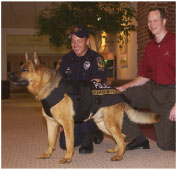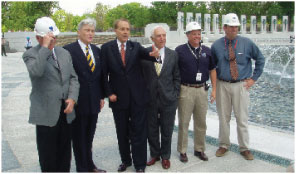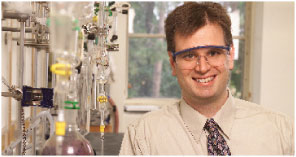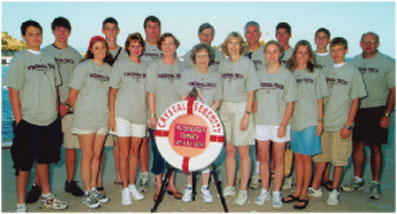|
Active in his duty by Megan Rowe
|

Lt. Todd Mills '96 (center) standing guard
during President Reagan's viewing
|
When thousands of supporters of former President Ronald Reagan gathered in Washington, D.C., for his viewing and funeral in June, U.S. Navy Ceremonial Guard member Lt. Todd Mills (political science '96) was part of both ceremonies. Mills, who stood guard at the head of Reagan's casket in the Rotunda and participated in the state funeral procession, was trained for such duties when he joined the ceremonial guard two years ago. "It's neat to be a part of a chapter of history," Mills says.
Tradition and pride run deep in Mills' family. His father, Dan Mills (ceramic engineering '64), was in the corps of cadets, and there was never any question that if Todd went to Virginia Tech, he would follow in his father's footsteps.
Because Mills had an ROTC scholarship, he knew that once he graduated, he'd be commissioned. "It gave me the opportunity to walk right out of school and have a job waiting for me," Mills says, noting the opportunities available in the Navy, such as his first sea tour, which took him to Japan, "a very rewarding experience."
|
Mills joined the ceremonial guard in February 2001. His second sea tour had ended and he was seeking a shore duty assignment close to his hometown of Petersburg, Va. A friend piqued his interest in the guard, but there's more to joining than just being interested, he says. "I had to be screened to be accepted into the program," a process that required a review of his service record and a letter of endorsement from his previous command before he was assigned to Naval District Washington.
In addition to standing guard at state funerals, Mills' duties include supervising the seven-week training process for ceremonial guard recruits and participating in funerals at Arlington National Cemetery, particularly for World War II and Korean War veterans.
Mills left active duty in early 2003 and worked as a Navy reservist on an undersea unit off Baltimore, but he returned when the ceremonial guard suffered a staff shortfall in February. Today, he doesn't foresee leaving anytime soon.
"It's a lot of hard work,” Mills says. "But it's such an honor to know that you're doing something for the families of the deceased person, something they will always cherish and remember."
Megan Rowe is an intern for Virginia Tech Magazine.
McGruff the Crime Dog may be famous, but he's certainly not the only canine taking a bite out of crime.
Hokie, a four-year-old German shepherd who joined the ranks of the Virginia Tech Police Department in late 2001, is instrumental in ensuring the safety of the Tech campus and community. And these days, his safety on the job is ensured by a $3,000 custom-fitted and personalized K-9 Kevlar™ bulletproof vest donated by the First State Chapter of the Alumni Association.
After reading an article about Hokie in the July 2003 VT NetLetter (http://www.vtnetletter.vt.edu/july03/feature1.html), First State Chapter member Steve Cason (mechanical engineering '89) contacted Hokie's handler, Officer Keith Weaver. "Officer Weaver described the hazards of Hokie's assignments, such as entering buildings where suspects are hiding," Cason says. Realizing that Hokie would benefit from a bulletproof vest, Cason contacted U.S. Armor, which manufactures the items. In response, his chapter initiated fundraising activities to enable the vest's purchase.

Hokie with Officer Weaver
and Steve Cason '89
|
"The donors were very generous when they heard that the funds were earmarked for a bulletproof vest for Hokie," Cason reports. "We would specifically like to thank Selma Ashley of the Pacific Obedience Association for her generous support of the project," he adds.
To be sure, Hokie is not just any dog, nor is his vest just any vest. In order to distinguish the canine as a police officer, the vest bears custom-made identification patches designed and tailored by Cason's mother-in-law, Betty Dedinas.
The first police dog used by a university in Virginia, Hokie (whose "given name" is Fabio) was bred in Germany, trained at an Ohio kennel, and personally selected by Weaver to serve as his partner. The pair completed a 12-week police dog training school in Roanoke, Va., and thereafter began their regular beat, patrolling the campus on foot, especially the residence halls.
Officer Hokie's duties entail much more than routine dorm checks, however. Last year alone, the robust shepherd helped catch nine suspects, and he sniffed out 44 pounds of marijuana, his biggest drug bust to date. "Hokie is an awesome partner," confirms Weaver.
|
Just as Officers Hokie and Weaver are to be commended for their dedicated service to Virginia Tech, so is the First State Chapter of the Alumni Association, for the group has demonstrated yet another dynamic way that alumni enact the university's motto, Ut Prosim (That I May Serve).
|
Alum sees memorial to completion by Richard Lovegrove
|

Ken Terry ’94 (far right) with U.S. Sen. John
Warner (2nd from left) and former Sen. Bob
Dole (3rd from left) at the WW II Memorial.
|
Last year when the World War II Memorial in Washington, D.C., was about two-thirds finished, Ken Terry (civil engineering '94) slipped his aging maternal grandfather and WW II veteran, retired Col. N.J. "Nick" Bruno, in for a sneak preview. Bruno was excited and proud, and he offered Terry some advice: "This is very important. Don't screw it up."
Bruno passed away before the memorial opened to the public on April 29, but his advice wasn't lost on Terry, whose paternal grandfather, Marine Capt. M.A. "Red" Terry, also fought in the war (he was captured at Wake Island but survived to also fight in Korea). As senior project manager for the $70 million memorial, Ken Terry was the top on-site person overseeing day-to-day operations and administering the contract with U.S. agencies. He came to realize how important the project was to WW II veterans, who are dying at a rate of about 1,100 per day. As the project wound down, he spent a lot of time with them and saw the excitement the memorial caused.
|
"It was an unreal experience," says Terry, who is a senior project manager for Tompkins Builders and spent 31 months on the memorial. "I was extraordinarily fortunate to be in the right place at the right time. It was extraordinarily moving to be here and see the project completed."
Terry and the partnership of Tompkins and Grunley-Walsh Construction had to put forth all of their abilities to overcome obstacles and keep the memorial on schedule. The entire western side of the National Mall is former marshland, so workers had to deal with a shallow water table and unstable soil necessitating complete excavation for the foundation. There was also the potential presence of arsenic and heavy metals. Last fall, Hurricane Isabel threatened to do some harm, but the only damage was a scuffed granite pillar.
All in all, Terry says, it was the experience of a lifetime. "It was different from anything I've ever done--and from anything I'll ever do again."
Richard Lovegrove is an editor for University Relations.
|
|
From fake diamonds to rocket fuel by Gretchen Woods '95
|
 |
Zirconium is used to make everything from fake diamonds to underarm deodorant. But thanks to one Virginia Tech alumnus, zirconium-containing compounds may one day be used to produce things like rocket fuel and pharmaceuticals.
Paul Chirik (chemistry '95) has found a way to split molecular nitrogen using a zirconium compound. He and his research team at Cornell published their work in the Feb. 5 issue of the science journal Nature. Chirik's work is still experimental, but he says there are plenty of potential applications for the process. Products as diverse as fabric dye and fertilizers all contain nitrogen, which he describes as "the business end of all sorts of drugs."
|
Getting nitrogen into a useful form, however, can be tricky. The gaseous nitrogen found in the air we breathe consists of two nitrogen atoms tightly bound together. Separating those atoms is necessary before nitrogen will react with anything else, but it's difficult to accomplish. The most common reaction used to split nitrogen molecules hasn't changed much since it was developed more than 70 years ago. Though widely used, it requires extremely high temperatures and pressures to get the job done. Chirik's new nitrogen-splitting process requires much milder conditions: it uses hydrogen at standard atmospheric pressure to produce ammonia at temperatures below 100 degrees Celsius.
Still, producing ammonia is only the first step to making nitrogen-containing products. Chirik hopes his process will allow chemists to make these products directly without stopping at the ammonia stage. "We never got into this to make ammonia," Chirik says. "You do it because you sort of have to. When you get nitrogen on a metal, people will ask you, 'Can you make ammonia from it?' Just because it's the thing that people understand.”
Chirik received his doctorate at Cal Tech and did post-doctoral work at MIT, but he says the faculty members at Virginia Tech were some of his best mentors. "If I had to credit one person who put me on the path to what I do now, it's Joe Merola," Chirik says of his undergraduate research adviser. "He was the one who taught me about passion in chemistry. He really got me fired up about doing chemistry in the lab, and he taught me the fun of making discoveries and having a project of your own and making an impact on the scientific community. Joe really set me on the path for success."
For more information on Chirik's research, visit his website at Cornell University: http://www.chem.cornell.edu/teh24/.
Gretchen Woods (chemistry ’95) is a freelance writer in Richmond, Ky.
|
Here's a Hokie, there's a Hokie . . .
|
| If you were in the Mediterranean this July, it would have seemed that everywhere, there was a Hokie. That's when former university President Paul Torgersen (back row, center) and his wife, Dot (front row, center), took their three children and nine grandchildren on a cruise to celebrate 50 years of marriage. Of the 17 people in this photo, seven are Tech grads, one is a student, two more are applying to the university . . . and one, of course, capped his 30-year career at Tech with six years as president. Good taste must run in the family.
|
 |
|




